The Hatha Yoga Pradipika Our Books Bhagavad Gita Gheranda Samhita Hatha Yoga Pradipika Kamasutra Shiva Samhita The Hatha Yoga Pradipika The Original Sanskrit Svatmarama An English Translation Brian Dana Akers YogaVidya.com An important message to our readers: The asanas in this book should not be attempted without the supervision of an experienced teacher or prior experience. Many of the other practices should not be attempted at all. The ideas expressed in this book should not be used to diagnose, prescribe, treat, cure, or prevent any disease, illness, or individual health problem. Consult your health care practitioner for individual health care. YogaVidya.com LLC shall not be liable for any direct, indirect, incidental, special, consequential, or punitive damages resulting from the use of this book. YogaVidya.com, PO Box 569, Woodstock NY 12498-0569 USA Copyright 2002 YogaVidya.com LLC.
Includes Sanskrit and English. ISBN 0-9716466-0-0 (hardcover) ISBN 0-9716466-1-9 (paperback) ISBN 978-0-9899966-4-8 (ebook) 1. Yoga, Hatha. 2. Kundalini. Title. II. II.
Introduction
O VER THE last half millennium, one book has established itself as
the classic work on Hatha Yogathe book you are holding in your hands. An Indian yogi named Svatmarama wrote the
Hatha Yoga Pradipika in the fifteenth century C.E. Next to nothing is known about him, although his name may provide a clue. It means one who delights in ones Atman, indicating the achievement of a state of bliss. Drawing on his own experience and older works now lost, he wrote this book for the student of Yoga. He wrote this book for you.
Youve no doubt heard of Hatha Yoga. The word pradipika comes from the Sanskrit verb  to flame forth and means a light, lamp, or lantern. Its extended meaning, since one is throwing light on a subject, is an explanation or commentary. Therefore, the title means An Explanation of Hatha Yoga. Even though Ive worked hard to make it understandable, this book, like Yoga itself, will require some effort from you. (Perhaps it also contains a bit of hyperbole.) It is not a smooth, modern narrative, but rather an esoteric work, purposely oblique at times, from medieval India. (Perhaps it also contains a bit of hyperbole.) It is not a smooth, modern narrative, but rather an esoteric work, purposely oblique at times, from medieval India.
to flame forth and means a light, lamp, or lantern. Its extended meaning, since one is throwing light on a subject, is an explanation or commentary. Therefore, the title means An Explanation of Hatha Yoga. Even though Ive worked hard to make it understandable, this book, like Yoga itself, will require some effort from you. (Perhaps it also contains a bit of hyperbole.) It is not a smooth, modern narrative, but rather an esoteric work, purposely oblique at times, from medieval India. (Perhaps it also contains a bit of hyperbole.) It is not a smooth, modern narrative, but rather an esoteric work, purposely oblique at times, from medieval India.
Furthermore, I recommend that you learn Hatha Yoga under the guidance of an experienced teacher, not solely from this book. Some practices in this book I dont recommend at all. (Youll know them when you read them.) This is nothing new. Looking at verses 2.37 and 3.22, you can see there have long been different opinions on what should and shouldnt be practiced. This book is divided into four chapters. In chapter 1, Svatmarama salutes his teachers, says why he is writing this book, who he is writing it for, where and how Yoga should be practiced, describes fifteen asanas, and recommends dietary habits.
In chapter 2, he establishes the connections between breath, mind, life, nadis, and prana, then describes the six karmans and the eight kumbhakas. In chapter 3, Svatmarama says what mudras are for, then describes the ten mudras. In chapter 4, he discusses samadhi, laya, nada, two mudras, and the four stages of Yoga. The Sanskrit original is complete and correct. I carefully examined four previous editions of the text word by wordin fact, letter by letterto produce the best, most aesthetically pleasing version of the original Sanskrit ever published. I favored more sandhi over less, and took the liberty of simplifying and standardizing the sentence that concludes each chapter.
Lines and verses were grouped the way they were translated, but the numbering was left unchanged. I utilized Arabic numerals and left the translation unnumbered to avoid clutter. While including the Sanskrit for the benefit of scholars, students, and posterity, its inclusionallowing easy comparison with the Englishis also a statement of confidence in the quality of the translation. The English translation is both accurate and accessible. To make it accurate, I stayed in the background and put myself at the service of the author and the text. I suppressed any urges to coin neologisms and employ fleeting usage, or to add my own comments and interpretations.
The verse was made the unit of translation to stay off the slippery slope of paraphrase. Where the meaning is open to interpretation, I followed the tradition, specifically Brahmanandas Jyotsna commentary. Due to the ever-increasing knowledge of the reading public, more words were left untranslated than would have been a quarter century ago. (You may want a dictionary of Yoga handy.) Some previous translators inexplicably suffocated the books wonderful parallel constructions; I allowed them to breathe. The translation is gender neutral where appropriate, but many words in the original are gendereven anatomicallyspecific, and were left that way. Finally, almost every word in the original made it into the translation.
Few were left out, and very few new words were added. I did many things to make the translation accessible. I tried to use international standard written English and produce prose that is clear, concise, and direct. To that end, I often broke a long Sanskrit sentence into shorter English ones, typically changed the word order from subject-object-verb to subject-verb-object, favored the active voice over the passive, added the necessary punctuation, and occasionally moved the latter part of a line or verse to the beginning for a better flow. Diacritics, italics, and the heavy use of brackets were dispensed with to avoid the hyperdensity common in books on Indian philosophy. (However, I retained the familiar Sri instead of going with Shri, and went with yogi instead of the more correct yogin.) I invite the stickler for spelling and pronunciation to learn Devanagariits a delightful writing system. (However, I retained the familiar Sri instead of going with Shri, and went with yogi instead of the more correct yogin.) I invite the stickler for spelling and pronunciation to learn Devanagariits a delightful writing system.
Compounds are generally open to avoid long strings of unfamiliar letter combinations, although when compounded, the words bandha, mudra, kumbhaka, and karman are the final members of a closed compound for consistency within each category and with the asanas. Lastly, I regularly changed the third person potential mood found in many descriptions to a simple imperative. For example, in verse 1.20, One should put the right ankle becomes simply Put the right ankle. Knowing a few more things will make this book easier to follow. In Svatmaramas use of language, time equals death, nadis are rivers or streams, chakras are lotuses, sun and moon each refer to multiple things, and the fluid said to drip from a cavity in the skull is variously called soma, nectar, essence, juice, liquor, or crescent water. Kumbhaka means pranayama in general (verse 3.126), breath retention in particular (verse 2.71), and eight specific practices (verse 2.44).
Objects means objects of the senses, and without objects more literally means independent or without support. Practices are almost always described before they are named. For example, Simhasana is described in verses 1.50 and 1.51, but not named until verse 1.52. Practices have also changed over the centuries, as have the names attached to them. Indeed, verse 1.37 gives four different names for one asana. In our photographs, we gave primacy to the (often terse and incomplete) descriptions in the book, then filled in the details according to current understanding of the asanas.

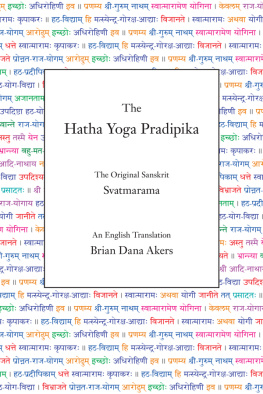

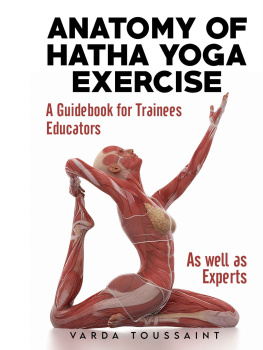
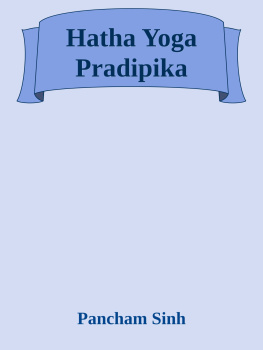

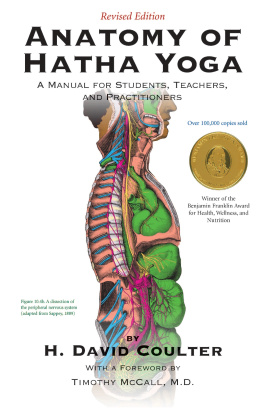

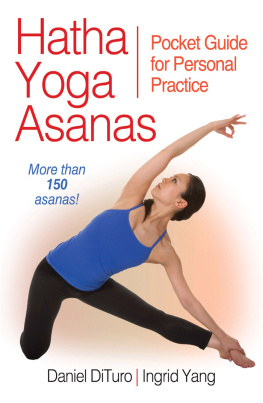
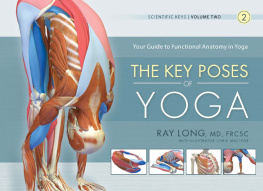
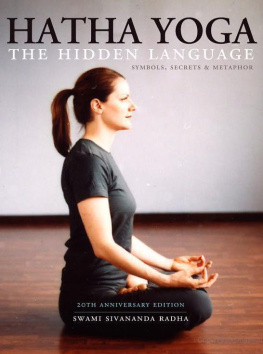
 to flame forth and means a light, lamp, or lantern. Its extended meaning, since one is throwing light on a subject, is an explanation or commentary. Therefore, the title means An Explanation of Hatha Yoga. Even though Ive worked hard to make it understandable, this book, like Yoga itself, will require some effort from you. (Perhaps it also contains a bit of hyperbole.) It is not a smooth, modern narrative, but rather an esoteric work, purposely oblique at times, from medieval India. (Perhaps it also contains a bit of hyperbole.) It is not a smooth, modern narrative, but rather an esoteric work, purposely oblique at times, from medieval India.
to flame forth and means a light, lamp, or lantern. Its extended meaning, since one is throwing light on a subject, is an explanation or commentary. Therefore, the title means An Explanation of Hatha Yoga. Even though Ive worked hard to make it understandable, this book, like Yoga itself, will require some effort from you. (Perhaps it also contains a bit of hyperbole.) It is not a smooth, modern narrative, but rather an esoteric work, purposely oblique at times, from medieval India. (Perhaps it also contains a bit of hyperbole.) It is not a smooth, modern narrative, but rather an esoteric work, purposely oblique at times, from medieval India.